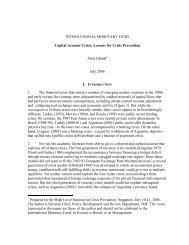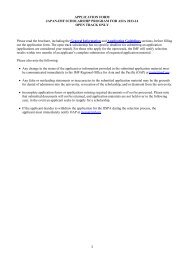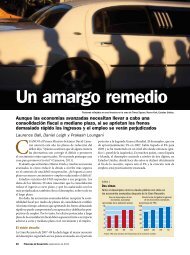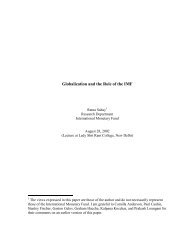Chapter 20: Taxation of Corporate Reorganizations - IMF
Chapter 20: Taxation of Corporate Reorganizations - IMF
Chapter 20: Taxation of Corporate Reorganizations - IMF
You also want an ePaper? Increase the reach of your titles
YUMPU automatically turns print PDFs into web optimized ePapers that Google loves.
Tax Law Design and Drafting (volume 2; International Monetary Fund: 1998; Victor Thuronyi, ed.)<br />
<strong>Chapter</strong> <strong>20</strong>, <strong>Taxation</strong> <strong>of</strong> <strong>Corporate</strong> <strong>Reorganizations</strong><br />
harsh, however, in that the difference between the fair market value <strong>of</strong> the inventory and its<br />
historic valuation (which will be artificially low because <strong>of</strong> the use <strong>of</strong> LIFO) is taxable.<br />
D. <strong>Reorganizations</strong> Without Transfer <strong>of</strong> Assets or Shares<br />
Some forms <strong>of</strong> reorganization deal with only one company, for example, with changes in<br />
corporate seat or form and various forms <strong>of</strong> recapitalization.<br />
1. Change <strong>of</strong> <strong>Corporate</strong> Seat or Form<br />
The change <strong>of</strong> corporate seat or form is a simple form <strong>of</strong> reorganization involving a<br />
change in the legal structure <strong>of</strong> the business but not its economic structure. A change in<br />
corporate seat should not have any tax consequence as long as the seat <strong>of</strong> the company stays<br />
within the same tax jurisdiction. When the seat changes from one tax jurisdiction to another,<br />
however, there may be full taxation <strong>of</strong> the company, as if it had distributed all its assets in a<br />
liquidating distribution. 40 This rule reflects the fact that after the move the company will no<br />
longer be subject to the national tax jurisdiction.<br />
A mere change in corporate form (e.g., from a limited-liability company to a share<br />
company) should in principle not give rise to any tax liability. All assets and liabilities <strong>of</strong> the<br />
business remain within a single legal entity, albeit a different one, and the shareholders maintain<br />
their equity interest unchanged. In a few countries, a change <strong>of</strong> form may result in tax problems<br />
because company law may require a formal liquidation in order to change the company form, so<br />
that there is a legal transfer <strong>of</strong> assets and liabilities from the old company to the new. 41<br />
Typically, however, the transfer is automatic and everything remains unchanged except for the<br />
company form. For tax purposes, the mere change__f company form should not be considered a<br />
taxable event, as long as the change is limited to the legal form <strong>of</strong> the company and its assets,<br />
capital, debt, and outstanding shares remain unchanged.<br />
There may be a problem, however, when, as a result <strong>of</strong> a change in corporate form, the<br />
company changes its taxpayer status from corporate to flow-through treatment or vice versa. 42 It<br />
is clear that the tax law should provide for adjustments, when, as a result <strong>of</strong> a change in the form<br />
<strong>of</strong> the legal entity, its tax regime is also changed from one regime to the other. In such cases a<br />
40 Often the transaction is accomplished by forming a new corporation in the state where it is desired to move to and<br />
then merging the corporation into this new corporation. See supra note 18; Rufus Rhoades & Marshall Langer, 2<br />
Income <strong>Taxation</strong> <strong>of</strong> Foreign-related Transactions § 7.02[8] (1996); Notice 94-46, 1994-1 C.B. 356. In some cases, a<br />
change in place <strong>of</strong> incorporation will not be taxable; e.g., Rev. Rul. 87-27, 1987-1 C.B. 134 (liquidation <strong>of</strong> domestic<br />
corporation into a newly formed foreign corporation treated as a change in place <strong>of</strong> incorporation and hence as a<br />
Type F reorganization, which was tax free where the requirements <strong>of</strong> the regulations under IRC § 367(a) were<br />
satisfied).<br />
41 See supra note 18.<br />
42 See infra ch. 21.<br />
- 12 -
















